If you’re looking for a colorful and lively addition to your aquarium, the Electric Blue Ram fish might be just what you need. These small and vibrant fish are native to South America and are a popular choice for both novice and experienced fish keepers. In this article, we’ll cover everything you need to know about Electric Blue Ram care, including their habitat, diet, behavior, and more.
Electric blue rams require a well-maintained aquarium with suitable water conditions, a varied diet, and a peaceful environment. They need a pH range of 5.0-7.5 and a temperature range between 78-85°F. The aquarium should be planted, and regular water changes should be performed to ensure their health. They are peaceful and social fish, making them an excellent choice for community tanks.
As a fish owner myself, I know how important it is to provide the best possible care for our aquatic pets. The Electric Blue Ram fish is no exception, and it’s essential to understand their unique needs to ensure they thrive in your aquarium. From the water parameters to the type of food they eat, we’ll provide you with all the information you need to create a healthy and happy environment for your Electric Blue Ram fish.
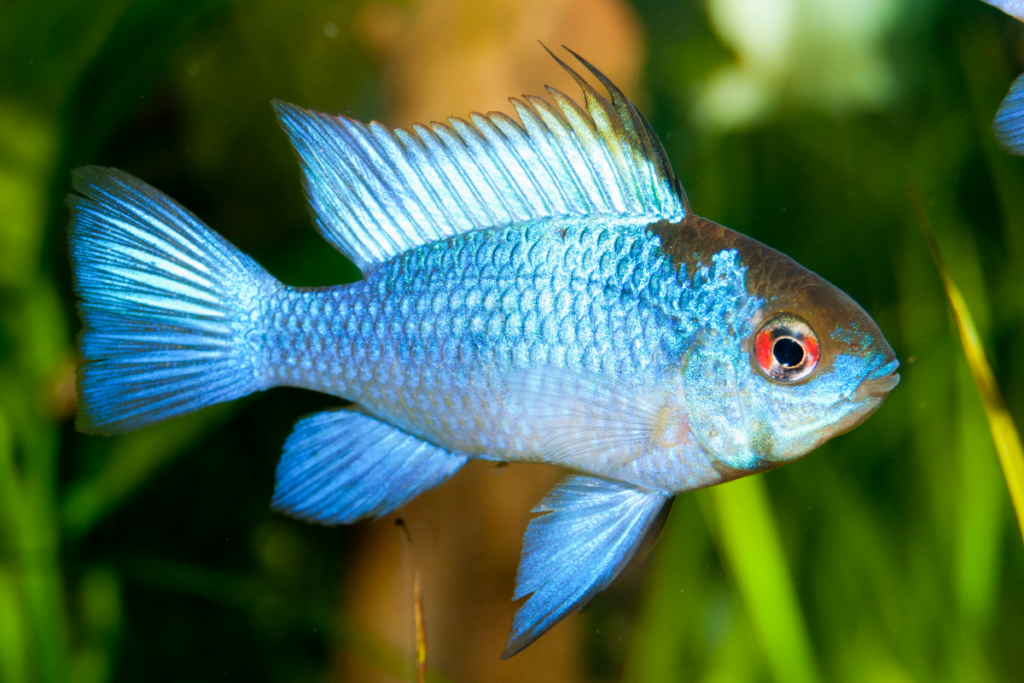
Table of Contents
Species Summary
The Electric Blue Ram, also known as Mikrogeophagus ramirezi, is a freshwater fish species that is native to the Orinoco River basin in South America. This species is a popular choice for aquarium enthusiasts due to its vibrant blue coloration and peaceful nature. In this section, we will discuss the origin, lifespan, appearance, size, growth rate, behavior, and temperament of Electric Blue Rams.
Origin
Electric Blue Rams are native to the Orinoco River basin in South America. They can be found in slow-moving rivers, streams, and pools with sandy or muddy bottoms. They prefer areas with plenty of vegetation and hiding places, such as rocks, caves, and driftwood.
Lifespan
The average lifespan of an Electric Blue Ram is around 2-3 years in captivity. However, with proper care and maintenance, they can live up to 4-5 years.
Appearance
Electric Blue Rams are known for their striking blue coloration, which covers their entire body. They also have a yellow underside and red eyes. The fins of the male are more elongated and pointed than the female. They have a round body shape and a small mouth.
Size
Electric Blue Rams are a small species of fish, with an average adult size of 2-3 inches in length.
Growth rate
The growth rate of Electric Blue Rams is relatively slow, with an average growth rate of 0.5 inches per year. They reach sexual maturity at around 6 months of age.
Behavior & Temperament
Electric Blue Rams are peaceful and social fish that enjoy the company of their own species. They are known to be shy and can be easily intimidated by larger or more aggressive fish.
They are also known to be territorial, especially during breeding season. It is recommended to keep them in a tank with plenty of hiding places and vegetation to help reduce stress.
I once had an Electric Blue Ram in my aquarium, and I was amazed by its vibrant blue coloration. It was a peaceful fish that enjoyed swimming around with its tank mates.
However, I noticed that it became more territorial during breeding season and would chase away other fish that came too close to its territory. Overall, it was a joy to have in my aquarium.
Habitat and Tank Requirements
Tank Size
When it comes to Electric Blue Ram care, the first thing to consider is the tank size. These fish need at least a 20-gallon tank to thrive.
A larger tank is always better, as it provides more space for the fish to swim and reduces the risk of water quality issues.
Filtration and Aeration
Good filtration and aeration are crucial for the health of Electric Blue Rams. A good quality filter should be able to process the entire volume of the tank at least four times per hour.
In addition, an air pump can provide extra oxygenation and help keep the water moving.
Lighting
Electric Blue Rams do not require intense lighting, but a moderate amount of light is necessary to support the growth of live plants.
A basic aquarium light will suffice, and it should be on for around 8-10 hours per day.
Heater
Electric Blue Rams are tropical fish and require a consistent water temperature between 78-82°F.
A good quality heater is essential to maintain the correct temperature, and a thermometer should be used to monitor it.
Substrate
A fine-grained substrate such as sand or gravel is ideal for Electric Blue Rams.
They like to dig and sift through the substrate, so larger gravel or sharp-edged rocks should be avoided.
Decoration
Electric Blue Rams appreciate a well-decorated tank with plenty of hiding places. Rocks, caves, and driftwood are all great options.
Be sure to choose decor that is safe for aquarium use and won’t leach harmful chemicals into the water.
Plants
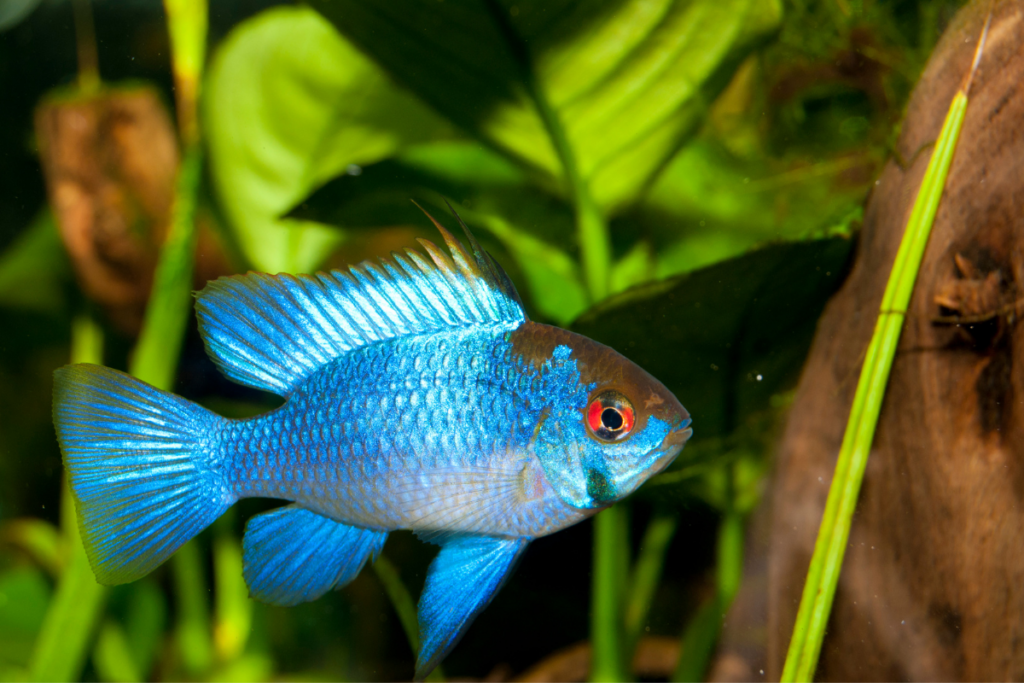
Live plants provide many benefits for Electric Blue Rams, including oxygenation, natural filtration, and a place for them to hide.
Choose plants that are compatible with the fish and lighting in your tank, and be sure to provide adequate nutrients and lighting for their growth.
Overall, providing a suitable habitat and tank environment is crucial for the health and well-being of Electric Blue Rams.
With the right equipment and care, these fish can thrive and make a beautiful addition to any aquarium.
Water Parameters
Water Temperature
The ideal temperature for Electric Blue Rams is between 78-82°F (25.5-27.8°C). Keeping the water at this temperature range will help the fish thrive and remain healthy.
It is important to avoid sudden fluctuations in temperature as it can cause stress and harm the fish.
Water pH
The pH level of the water should be between 6.0-7.5 for Electric Blue Rams to thrive. Keeping the pH level stable is crucial as sudden changes can cause stress and harm the fish.
You can use a pH test kit to monitor the pH level of the water and make adjustments as necessary.
Water Hardness
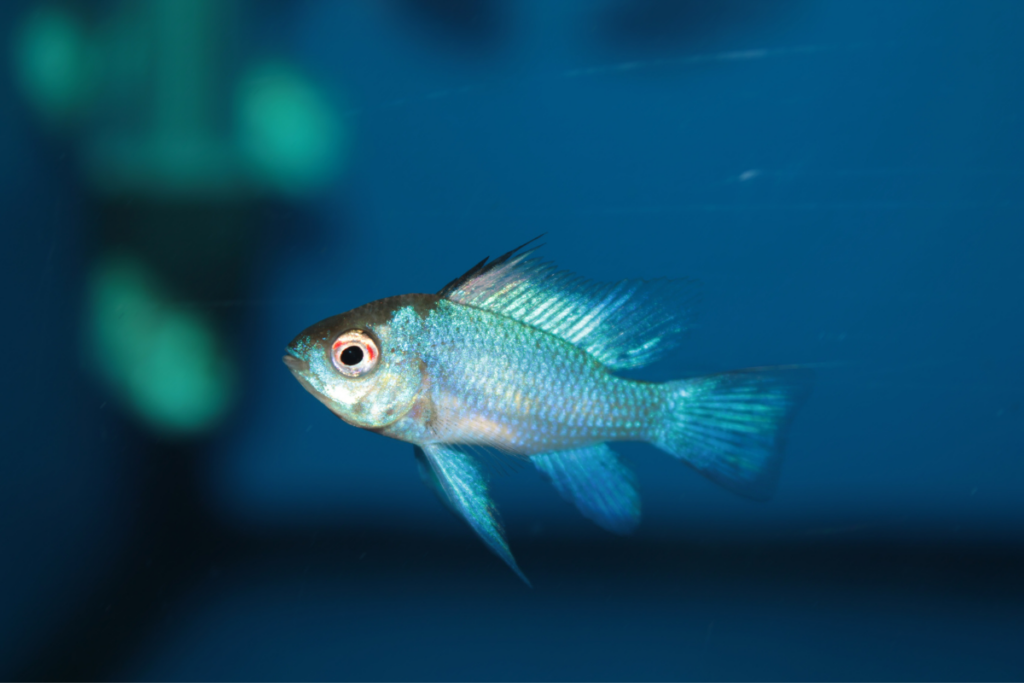
The water hardness should be between 5-15 dGH for Electric Blue Rams. Soft to medium-hard water is ideal for these fish.
You can use a water hardness test kit to monitor the hardness level of the water and make adjustments as necessary.
Water Changes
It is important to perform regular water changes to maintain the water quality and keep the fish healthy. A 25% water change every two weeks is recommended for Electric Blue Rams.
When performing water changes, make sure to use a dechlorinator to remove any harmful chemicals from the water.
Personally, I have found that performing water changes every week instead of every two weeks has helped keep my Electric Blue Rams healthy and vibrant. It may require a bit more effort, but the results are worth it.
Feeding and Nutrition
Diet
Electric Blue Rams are omnivores and require a varied diet to maintain their health. In the wild, they primarily feed on small insects, crustaceans, and plant matter.
In captivity, they should be fed a diet that includes high-quality pellets or flakes, frozen or live foods such as brine shrimp, bloodworms, and daphnia, and fresh vegetables such as spinach and peas.
It is important to provide a balanced diet to avoid nutritional deficiencies and health problems.
Feeding Schedule
Adult Electric Blue Rams should be fed once or twice a day, with smaller meals more frequently preferred.
Overfeeding can lead to obesity and health problems, so it is important to monitor their food intake. Younger Rams may require more frequent feedings, up to three times a day.
It is best to feed them at the same time each day to establish a routine and prevent stress.
When feeding, it is important to observe their behavior and adjust the amount of food accordingly.
Rams should be able to consume all the food within a few minutes, and any excess should be removed to prevent water quality issues.
It is also recommended to occasionally fast the Rams for a day to mimic their natural feeding patterns and promote digestion.
Personal Anecdote: I have found that my Electric Blue Rams are particularly fond of frozen bloodworms and will eagerly swim to the surface to feed. However, I have also noticed that they tend to ignore pellets unless they are soaked in water first. It is important to experiment with different types of food to find what works best for your Rams.
Behavior and Compatibility of Electric Blue Rams
Aggression
Electric Blue Rams are known for their peaceful nature, but like all fish, they can become aggressive under certain circumstances.
Males can become territorial during breeding season and may become aggressive towards other males.
However, this aggression is usually short-lived and does not result in serious injury. It is important to provide plenty of hiding places in the aquarium to help minimize aggression.
Tank Mates
Electric Blue Rams are generally compatible with other peaceful fish that are similar in size. Good tank mates include tetras, rasboras, and other peaceful cichlids.
However, it is important to avoid keeping Electric Blue Rams with aggressive or territorial fish, as this can lead to stress and injury.
Additionally, it is important to avoid keeping Electric Blue Rams with fish that are too small, as they may be seen as prey.
How Many Electric Blue Rams Can I Keep Together?
When it comes to keeping Electric Blue Rams together, it is important to consider the size of your aquarium.
As a general rule, you should keep no more than one male Electric Blue Ram per 20 gallons of water. Females can be kept in groups of three or more, as long as there is only one male present.
Keeping multiple males in the same aquarium can lead to aggression and stress.
Overall, Electric Blue Rams are peaceful and easy to care for, but it is important to provide them with a suitable environment and compatible tank mates.
With proper care, these beautiful fish can provide years of enjoyment in your aquarium.
Personally, I have kept Electric Blue Rams in a community aquarium with neon tetras and corydoras catfish and they have all gotten along great. Watching the Electric Blue Rams swim and interact with each other is truly a sight to behold.
Common Diseases and Treatment
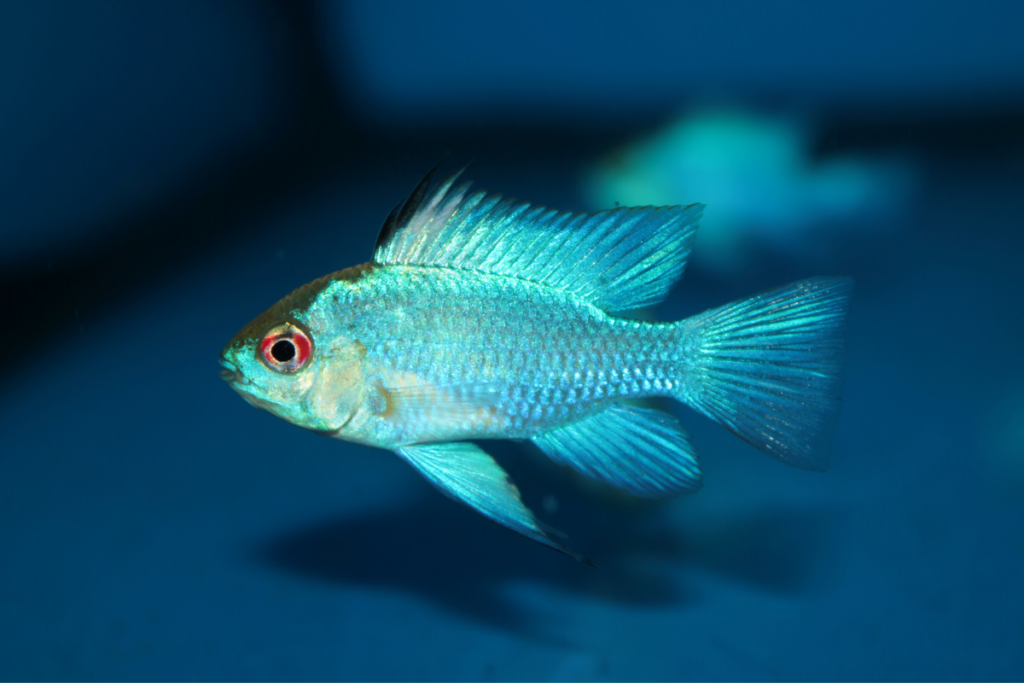
Common Diseases
Electric Blue Rams are generally hardy fish, but they are still susceptible to a few common diseases.
One of the most common diseases that can affect Electric Blue Rams is Ich, which is a parasitic disease caused by the protozoan Ichthyophthirius multifiliis.
Other common diseases include bacterial infections, fungal infections, and fin rot.
Symptoms
The symptoms of Ich include white spots on the body and fins, flashing, rubbing against objects, and difficulty breathing.
Bacterial infections can cause symptoms such as redness, swelling, and open sores on the body and fins.
Fungal infections can cause a cotton-like growth on the body and fins, while fin rot can cause the fins to become frayed or disintegrate.
Prevention
To prevent diseases, it is important to maintain good water quality and keep the aquarium clean.
Electric Blue Rams prefer slightly acidic water with a pH between 6.0 and 7.0, and a temperature between 78°F and 82°F.
It is also important to avoid overfeeding and to quarantine new fish before adding them to the aquarium.
Treatment
If your Electric Blue Ram is showing signs of disease, it is important to act quickly to prevent the disease from spreading.
For Ich, treatment options include raising the temperature of the water to 86°F for several days or using a medication containing malachite green or copper.
Bacterial and fungal infections can be treated with medications such as antibiotics or antifungals. Fin rot can often be treated by improving water quality and adding aquarium salt to the water.
When it comes to treating diseases, it is important to follow the instructions on the medication carefully and to continue treatment until the disease is completely gone.
It is also important to keep the aquarium clean and maintain good water quality to prevent the disease from returning.
Personally, I have had success treating Ich by raising the temperature of the water and using a medication containing malachite green.
However, it is important to note that every fish and aquarium is different, so it is important to consult with a veterinarian or experienced fish keeper if you are unsure about how to treat a disease.
Signs of a Healthy Electric Blue Ram
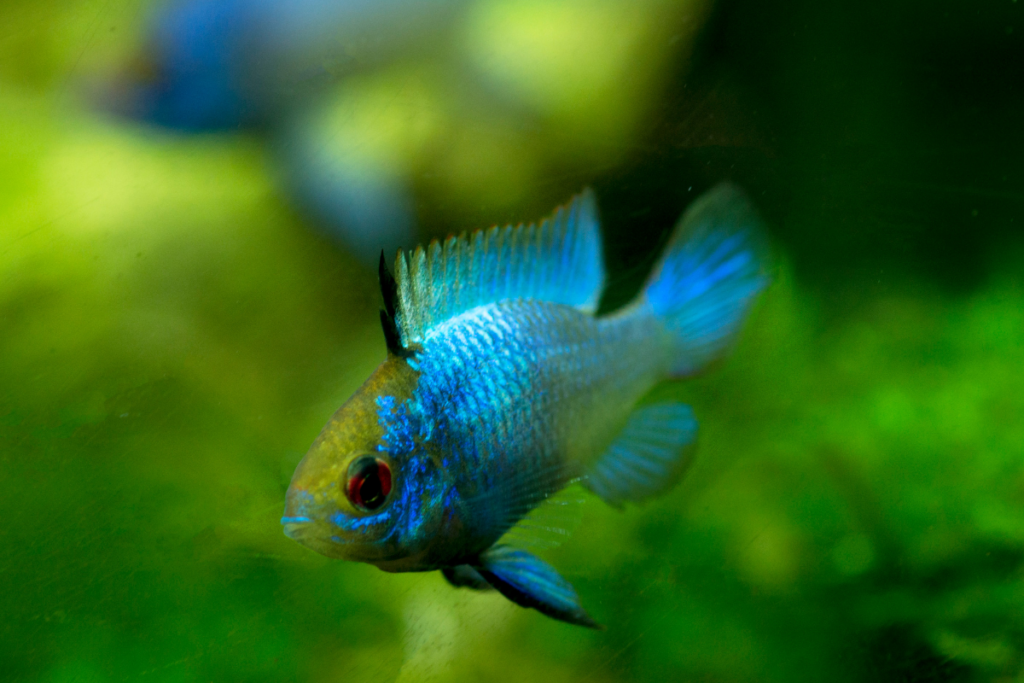
When it comes to caring for an electric blue ram, it is crucial to know the signs of a healthy fish. Here are some things to look out for:
- Bright and Vibrant Colors: One of the most noticeable signs of a healthy electric blue ram is its bright and vibrant colors. The fish should have a deep blue body with yellow fins and black markings. If the colors appear dull or faded, it could be a sign of stress or illness.
- Active and Energetic: A healthy electric blue ram should be active and energetic, swimming around the tank and exploring its surroundings. If the fish appears lethargic or spends most of its time hiding, it could be a sign of poor health.
- Clear Eyes and Skin: The fish’s eyes should be clear and bright, with no cloudiness or discoloration. The skin should also be smooth and free of any bumps, lumps, or lesions.
- Healthy Appetite: A healthy electric blue ram should have a healthy appetite and eagerly eat its food. If the fish is not eating or appears disinterested in food, it could be a sign of illness.
It is important to note that even if a fish appears healthy, it can still be carrying diseases or parasites.
Regular tank maintenance, including water changes and filter cleaning, can help prevent the spread of illness in your aquarium.
Personally, I have found that observing my electric blue rams on a daily basis has helped me to quickly identify any changes in their behavior or appearance. By being attentive and proactive, you can help ensure the long-term health and well-being of your electric blue rams.
Signs of a Sick Electric Blue Ram
If you are keeping electric blue rams, it is important to be able to recognize signs of illness. Here are a few things to look out for:
- Loss of Appetite: If your electric blue ram is not eating or showing interest in food, it could be a sign of illness.
- Changes in Color: If your electric blue ram’s color appears faded or dull, it could be a sign of stress or illness.
- Erratic Swimming: If your electric blue ram is swimming in circles or appears to be struggling to swim, it could be a sign of swim bladder disease or another illness.
- Gasping for Air: If your electric blue ram is gasping for air at the surface of the water, it could be a sign of poor water quality or a respiratory illness.
- Visible Parasites: If your electric blue ram has visible parasites on its body, fins, or gills, it could be a sign of a parasitic infection.
If you notice any of these signs, it is important to take action quickly. Isolate the sick fish and observe it closely for any other symptoms.
Consider testing your water parameters and making any necessary adjustments.
You may also want to consult with a veterinarian or experienced aquarist for advice on treatment options.
Personally, I once had an electric blue ram that suddenly lost its appetite and started swimming erratically. I quickly isolated it and observed it closely for any other symptoms. After consulting with an experienced aquarist, I treated the fish with a combination of aquarium salt and antibiotics, and it made a full recovery.
Breeding
Mating
Electric Blue Rams are known to be monogamous and will often pair off for life. To encourage breeding, it’s best to keep a pair of rams in a separate breeding tank with soft, slightly acidic water and a temperature between 78-82°F.
The male will typically initiate courtship by displaying his fins and colors to the female.
Once the female is receptive, the pair will engage in a “dance” where they swim together and touch each other’s mouths. This is followed by the male leading the female to a flat surface where they will lay their eggs.
It’s important to note that breeding can be stressful for the fish, so it’s important to provide plenty of hiding places and plants to help them feel secure.
Additionally, make sure to remove any other fish from the breeding tank to prevent aggression and stress.
Fry Care
After the eggs are laid, the male will fertilize them and both parents will take turns guarding the eggs.
The eggs will hatch in about 3-4 days and the fry will be free-swimming after about 5-7 days.
At this point, it’s important to feed them small, frequent meals of baby brine shrimp or crushed flakes.
As the fry grow, it’s important to provide them with plenty of hiding places and plants to help them feel secure. It’s also important to keep the water clean and well-oxygenated.
The fry will start to develop their color after about 2-3 months and will be ready to breed themselves at around 6-8 months old.
Personal Anecdote: When I first started breeding Electric Blue Rams, I was so excited to see the eggs hatch and the fry grow.
It was amazing to watch the parents take turns guarding the eggs and caring for the fry. However, I quickly learned that it’s important to be patient and not rush the process.
Breeding can be stressful for the fish, so it’s important to provide them with a safe and secure environment to help them thrive.
Recommended products for the article:
- Fluval FX4 High Performance Canister Filter – This filter is recommended for a 20-gallon tank and can process the entire volume of the tank at least four times per hour, ensuring good filtration and aeration for Electric Blue Rams.
- Hygger Quiet Mini Air Pump – This air pump provides extra oxygenation and helps keep the water moving in the tank, promoting the health of Electric Blue Rams.
- NICREW ClassicLED Aquarium Light – This basic aquarium light is suitable for supporting the growth of live plants in the tank, which provide oxygenation, natural filtration, and hiding places for Electric Blue Rams.
- Aqueon Pro Adjustable Heater – This heater is recommended for maintaining a consistent water temperature between 78-82°F, which is essential for the health of Electric Blue Rams.
- CaribSea Super Naturals Aquarium Sand – This fine-grained substrate is ideal for Electric Blue Rams, as they like to dig and sift through the substrate, and it won’t harm their delicate fins.
- Penn-Plax Aquarium Decoration – This aquarium decoration provides hiding places for Electric Blue Rams and is made of safe materials that won’t leach harmful chemicals into the water.
- Seachem Flourish Plant Supplement – This plant supplement provides nutrients for live plants in the tank, promoting their growth and providing benefits for Electric Blue Rams.
- API Master Test Kit – This test kit allows you to monitor the pH level, water temperature, and water hardness of the tank, ensuring that the water parameters are suitable for Electric Blue Rams.
- Hikari Bio-Pure Freeze Dried Blood Worms – These freeze-dried bloodworms are a favorite food of Electric Blue Rams and provide a balanced diet for them.
- API Aquarium Salt – This aquarium salt can be added to the water to treat fin rot and promote the health of Electric Blue Rams.
Conclusion
Electric Blue Rams are stunning fish that can add a pop of color to any aquarium. They are relatively easy to care for, but require specific water parameters and a well-maintained tank.
By providing them with a suitable environment, a balanced diet, and proper care, you can ensure that your Electric Blue Ram will thrive.
Remember to keep the water temperature between 78-82°F and maintain a pH level between 6.0-7.5. They prefer soft, slightly acidic water with a low to moderate water flow. Make sure to provide plenty of hiding spots and plants for them to explore and feel secure in.
It’s important to note that Electric Blue Rams can be sensitive to changes in water parameters, so it’s crucial to monitor the water quality regularly. Perform weekly water changes of 25-30% to maintain a healthy environment for your fish.
When it comes to feeding, make sure to provide a varied diet consisting of high-quality pellets, flakes, and frozen or live foods. Feeding them small amounts twice a day is ideal, and don’t forget to remove any uneaten food to prevent water quality issues.
Overall, Electric Blue Rams can make a wonderful addition to any aquarium. With proper care and attention, they can live for up to 4-5 years. By following the guidelines outlined in this article, you can ensure that your Electric Blue Ram will live a happy and healthy life in your aquarium.
Personally, I have found that Electric Blue Rams are one of the most rewarding fish to keep in an aquarium. They are incredibly intelligent and have unique personalities. Watching them interact with each other and explore their environment is truly fascinating. I highly recommend them to any fish enthusiast looking for a colorful and captivating addition to their tank.
FAQs
Now that you know all about Electric Blue Ram care, let’s answer some common questions:
Q: How often should I feed my Electric Blue Ram?
A: It’s recommended to feed them twice a day, with a variety of high-quality foods such as frozen or live brine shrimp, bloodworms, and pellets. Make sure to not overfeed them as it can lead to health problems.
Q: Do Electric Blue Rams get along with other fish?
A: Yes, they are generally peaceful and can coexist with other non-aggressive fish. However, it’s important to make sure the tank is not overcrowded and that there are enough hiding places for all the fish.
Q: Can I keep Electric Blue Rams in a community tank?
A: Yes, they can be kept in a community tank as long as the other fish are not aggressive and the tank is big enough. It’s important to research and choose compatible tank mates.
Q: How often should I do water changes?
A: It’s recommended to do a 25% water change every two weeks to maintain good water quality. However, this can vary depending on the size of the tank and the number of fish.
Q: Can I keep Electric Blue Rams with live plants?
A: Yes, they can coexist with live plants. In fact, plants can provide hiding places and help maintain good water quality. However, be aware that they may eat some plants or uproot them.
Overall, Electric Blue Rams are a beautiful and fascinating fish that can make great additions to any aquarium. With proper care and attention, they can thrive and provide enjoyment for years to come.
Reference: Wikipedia.
